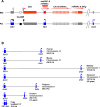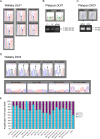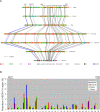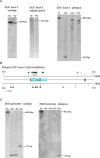The evolution of the DLK1-DIO3 imprinted domain in mammals
- PMID: 18532878
- PMCID: PMC2408620
- DOI: 10.1371/journal.pbio.0060135
The evolution of the DLK1-DIO3 imprinted domain in mammals
Abstract
A comprehensive, domain-wide comparative analysis of genomic imprinting between mammals that imprint and those that do not can provide valuable information about how and why imprinting evolved. The imprinting status, DNA methylation, and genomic landscape of the Dlk1-Dio3 cluster were determined in eutherian, metatherian, and prototherian mammals including tammar wallaby and platypus. Imprinting across the whole domain evolved after the divergence of eutherian from marsupial mammals and in eutherians is under strong purifying selection. The marsupial locus at 1.6 megabases, is double that of eutherians due to the accumulation of LINE repeats. Comparative sequence analysis of the domain in seven vertebrates determined evolutionary conserved regions common to particular sub-groups and to all vertebrates. The emergence of Dlk1-Dio3 imprinting in eutherians has occurred on the maternally inherited chromosome and is associated with region-specific resistance to expansion by repetitive elements and the local introduction of noncoding transcripts including microRNAs and C/D small nucleolar RNAs. A recent mammal-specific retrotransposition event led to the formation of a completely new gene only in the eutherian domain, which may have driven imprinting at the cluster.
Conflict of interest statement
Figures







Similar articles
-
Genomic imprinting at the mammalian Dlk1-Dio3 domain.Trends Genet. 2008 Jun;24(6):306-16. doi: 10.1016/j.tig.2008.03.011. Trends Genet. 2008. PMID: 18471925 Review.
-
[Review on the genomic imprinting at the mammalian DLK1-DIO3 cluster.].Yi Chuan. 2010 Aug;32(8):769-78. doi: 10.3724/sp.j.1005.2010.00769. Yi Chuan. 2010. PMID: 20709673 Review. Chinese.
-
At least ten genes define the imprinted Dlk1-Dio3 cluster on mouse chromosome 12qF1.PLoS One. 2009;4(2):e4352. doi: 10.1371/journal.pone.0004352. Epub 2009 Feb 5. PLoS One. 2009. PMID: 19194500 Free PMC article.
-
Comparative phylogenetic analysis reveals multiple non-imprinted isoforms of opossum Dlk1.Mamm Genome. 2006 Feb;17(2):157-67. doi: 10.1007/s00335-005-0116-x. Epub 2006 Feb 7. Mamm Genome. 2006. PMID: 16465595
-
The microRNAs within the DLK1-DIO3 genomic region: involvement in disease pathogenesis.Cell Mol Life Sci. 2013 Mar;70(5):795-814. doi: 10.1007/s00018-012-1080-8. Epub 2012 Jul 24. Cell Mol Life Sci. 2013. PMID: 22825660 Free PMC article. Review.
Cited by
-
Postnatal epigenetic reprogramming in the germline of a marsupial, the tammar wallaby.Epigenetics Chromatin. 2013 Jun 3;6(1):14. doi: 10.1186/1756-8935-6-14. Epigenetics Chromatin. 2013. PMID: 23732002 Free PMC article.
-
Comparative gene expression signature of pig, human and mouse induced pluripotent stem cell lines reveals insight into pig pluripotency gene networks.Stem Cell Rev Rep. 2014 Apr;10(2):162-76. doi: 10.1007/s12015-013-9485-9. Stem Cell Rev Rep. 2014. PMID: 24338594
-
Evolutionary Conserved Motif Finder (ECMFinder) for genome-wide identification of clustered YY1- and CTCF-binding sites.Nucleic Acids Res. 2009 Apr;37(6):2003-13. doi: 10.1093/nar/gkp077. Epub 2009 Feb 10. Nucleic Acids Res. 2009. PMID: 19208640 Free PMC article.
-
Analysis of the platypus genome suggests a transposon origin for mammalian imprinting.Genome Biol. 2009;10(1):R1. doi: 10.1186/gb-2009-10-1-r1. Epub 2009 Jan 2. Genome Biol. 2009. PMID: 19121219 Free PMC article.
-
Imprinting and expression analysis of a non-coding RNA gene in the mouse Dlk1-Dio3 domain.J Mol Histol. 2011 Aug;42(4):333-9. doi: 10.1007/s10735-011-9337-3. Epub 2011 Jun 26. J Mol Histol. 2011. PMID: 21706278
References
-
- Edwards CA, Ferguson-Smith AC. Mechanisms regulating imprinted genes in clusters. Curr Opin Cell Biol. 2007;19:281–289. - PubMed
-
- Constancia M, Kelsey G, Reik W. Resourceful imprinting. Nature. 2004;432:53–57. - PubMed
-
- Kaneko-Ishino T, Kohda T, Ono R, Ishino F. Complementation hypothesis: the necessity of a monoallelic gene expression mechanism in mammalian development. Cytogenet Genome Res. 2006;113:24–30. - PubMed
-
- Charalambous M, Ferguson-Smith AC, Da Rocha ST. Genomic imprinting, growth control and the allocation of nutritional resources: consequences for postnatal life. Curr Opin Endocrin Diabetes, Obesity. 2007;14:3–12. - PubMed
Publication types
MeSH terms
Substances
Grants and funding
LinkOut - more resources
Full Text Sources
Other Literature Sources

